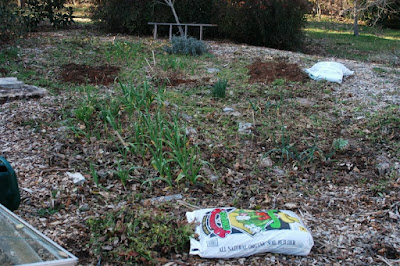Planting potatoes and onions
 The weather was perfect this weekend, spring-like even though it's technically still winter. The potatoes had sprouted nicely and the onion plants were ready to plant, so I went to work in the satellite garden, where the onions and potatoes have space to grow, and won't tempt emerging local woodchucks.My inadvertent foraging preference experiments last year revealed that potatoes are not appealing to woodchucks, thank goodness, nor were garlic or onions, in preference to all of the kales, beans, melons, cucumbers, okra, etc. which s/he/they ate with relish, I presume, judging by the pitiful stems that were left.
The weather was perfect this weekend, spring-like even though it's technically still winter. The potatoes had sprouted nicely and the onion plants were ready to plant, so I went to work in the satellite garden, where the onions and potatoes have space to grow, and won't tempt emerging local woodchucks.My inadvertent foraging preference experiments last year revealed that potatoes are not appealing to woodchucks, thank goodness, nor were garlic or onions, in preference to all of the kales, beans, melons, cucumbers, okra, etc. which s/he/they ate with relish, I presume, judging by the pitiful stems that were left.(I do have a new supply of something called 'Chuckster' and a woodchuck lure to hopefully catch and relocate whomever is unwise enough to emerge to forage in MY vegetable garden; in spite of my love for wildlife gardening, I figure woodchucks need to be out eating grass shoots, not my vegetables.)
 The garlic, shallot, and Welsh onion beds needed to be weeded in the tidying up process, and the potato and onion beds prepared. Some spading and turning over existing beds, adding mushroom compost and composted manure, and they were ready to plant.
The garlic, shallot, and Welsh onion beds needed to be weeded in the tidying up process, and the potato and onion beds prepared. Some spading and turning over existing beds, adding mushroom compost and composted manure, and they were ready to plant.In a couple of the potato beds, I'm trying a traditional trench method modified and described by Barbara Pleasant; create a 12 inch wide trench about 5 inches deep, put down about an inch of compost, then the sprouted potatoes, then mulch with a thick layer of straw.

 This helps keep the developing potatoes 'clean' -- similar to growing potatoes in hay bales. I don't mind, actually, poking around in my fluffy raised bed soil for potatoes, so I planted a couple of beds with amended soil covering the potatoes. I ordered a variety of seed potatoes from Wood Prairie Farm. There's something about about purple and yellow potatoes that's just plain appealing, reflecting their ancient Andean heritage, perhaps.
This helps keep the developing potatoes 'clean' -- similar to growing potatoes in hay bales. I don't mind, actually, poking around in my fluffy raised bed soil for potatoes, so I planted a couple of beds with amended soil covering the potatoes. I ordered a variety of seed potatoes from Wood Prairie Farm. There's something about about purple and yellow potatoes that's just plain appealing, reflecting their ancient Andean heritage, perhaps.
Comments
Post a Comment
I enjoy hearing from fellow nature lovers and gardeners. Let me know your thoughts.